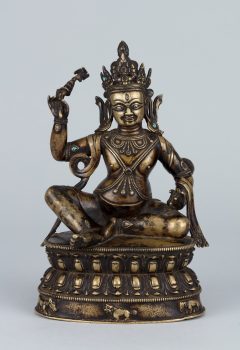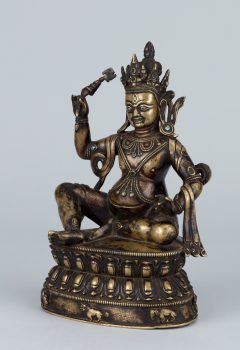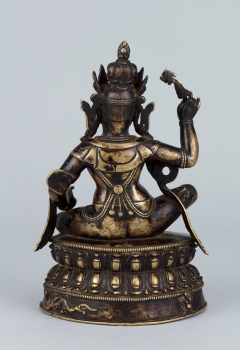Tibet
15th century




Tibet
15th century




Drenpa Namkha, from the Zhang Zhung region of the Himalayan Plateau, is regarded as an emanation of the founder of Tibet’s Bon religion, Tonpa Shenrab. Comparable to Buddhism’s Padmasambhava, Drenpa Namkha is the most important early teacher of Bon. He has acquired a cult status and is both worshiped and portrayed in art as a deity with many forms.This sculpture demonstrates that the same artists made both Buddhist and Bon images, as Drenpa Namkha is depicted with the characteristics of Indian siddhas. As is typical of early Tibetan sculpture, the head of this work is disproportionally large, with the hair-knot high and set back and the ribbons of the figure’s crown floating up beside his head. In his upper right hand he grasps a parasol that is topped by a yundrung (swastika), the most important symbol of the Bon religion.The double-lotus base with long and narrow petals became popular in the early fifteenth century, especially at the Chinese court, and is here rendered in a simpler Tibetan style. Of special interest among the animals depicted along the base, seen in the view above, is a dragon, a rare theme at that time.
The passing down of authentic Buddhist teachings from a teacher to a disciple or student, often in the form of a text in a ritualistic context.
The transmission of teachings from one generation to the next, from teacher to student, traced all the way back to the Buddha without interruption. A complete lineage is essential in Tantric Buddhist practices as it makes the blessings of the teaching more powerful.
Himalayan art includes portraits of legendary and historical humans, including accomplished religious teachers (lamas), the Buddha’s original disciples (arhats), and spiritually accomplished tantric masters (mahasiddhas).
Today, Tibetans primarily inhabit the Tibetan Plateau, situated between the Himalayan mountain range and the Indian subcontinent to the west, Chinese cultural regions to the east, and Mongolian cultural regions to the northeast. During the 7th to 9th century, Tibetan rulers expanded their empire across Central Asia, and established Buddhism as the state religion.
Get the latest news and stories from the Rubin, plus occasional information on how to support our work.